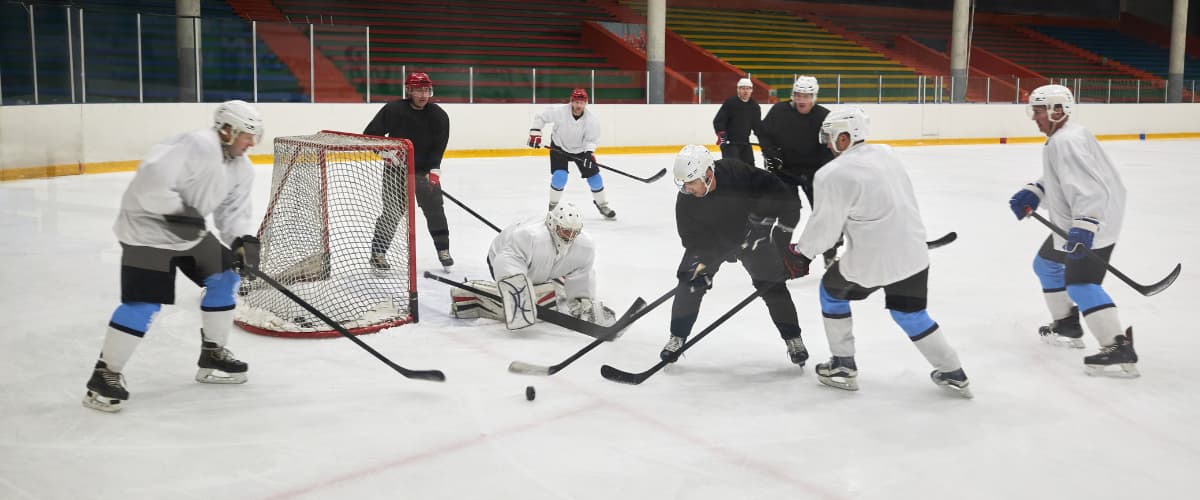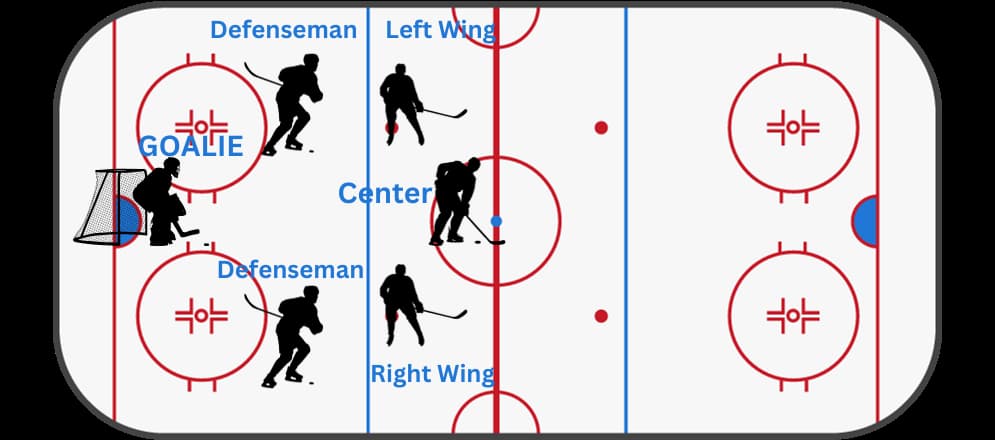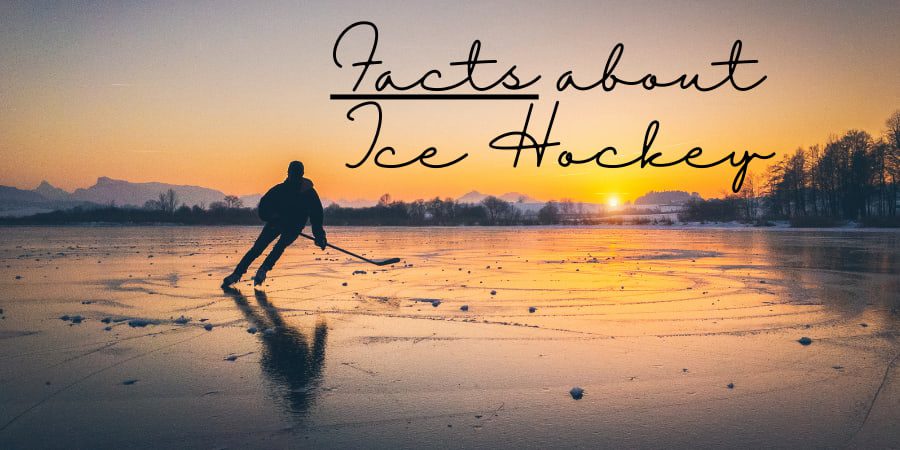Ice Hockey Positions: Ultimate Guide to Roles on the Ice
Ice hockey is a dynamic sport, driven by six distinct positions, each vital to the ebb and flow of the game. Here we explain the hockey positions! At the forefront, we have the three forwards: the center, responsible for directing offensive plays and face-offs; and the left and right wingers, who flank the center and focus on scoring and assisting. Anchoring the defense, there are the left and right defensemen, safeguarding against opposing offenses, and the indispensable goalie, the team’s last line of defense, tasked with blocking any shots on goal.
In every hockey game, each player knows their specific role and moves in coordination with others on the ice.
When my child first strapped on those skates, I admit I was befuddled by the different positions. But as games went by, I learned each one’s significance, and here’s my attempt to share that knowledge, starting with a breakdown of each.
Table of Contents
Hockey Positions on the Ice:
The Center Position in Hockey
In an ice hockey team, the center is essential, connecting offense and defense effectively. At the heart of the action, they juggle multiple responsibilities, making them one of the key ice hockey positions.
Observing a game, you’ll notice the center weaving strategies, connecting the left winger and the right winger, ensuring the team operates as a unified force.

To thrive in this role, a center boasts a specific toolkit. Mastery in puck control is essential, letting them sidestep opponents and maintain possession. Pinpoint passing ensures the puck reaches its destination, whether it’s a quick flick to a winger or a strategic pass to the rear guard. Decisiveness is crucial; centers often find themselves under the spotlight, making split-second choices. And of course, agility on skates gives them the edge, complementing both their attack and defense.
Positioning for a center varies depending on the situation.
In the offensive zone, they coordinate attacks, often receiving passes from wingers and setting up scoring opportunities.
In the defensive zone, their main responsibility is to disrupt the opposing team’s plays and to assist defensemen in protecting the net.
And let’s not forget the face-offs! Centers are usually the ones squaring off against their counterparts, aiming to gain control of the puck for their team.
Centers adapt their stance based on the game’s flow. Offensively, they are the architects, crafting plays and setting up goal-scoring moments. Defensively, they become shields, stalling rival strategies and supporting their defensemen. And who can overlook the face-offs? It’s typically the center who takes on the challenge, vying for puck dominance right from the whistle.

A simple rule: every center is a forward, but not vice versa. The left and right wingers share the forward title, but the center carries a unique set of duties, setting them apart in the roster of ice hockey team positions.
So, the next time the puck drops and you’re there, rooting for your budding star, you’ll have a richer understanding of the dynamic world of the center. And perhaps, this knowledge might just enhance your cheering game!
Left Wing Position in Hockey
Among the dynamic roles on the ice, the left winger is undeniably an offensive powerhouse within the forward position. As one of the main positions in an ice hockey team, their main task lies in creating offensive plays and strategizing maneuvers near the blue line. During a hockey game, they typically skate on the left side of the ice, making sure to exploit openings and capitalize on accurate shots.

Specific skills are essential for the left winger’s arsenal. Their prowess in puck handling, coupled with their ability to take accurate shots, can turn the tide in any game situation. Additionally, understanding team dynamics and the roles of different positions enhances their effectiveness, allowing them to collaborate seamlessly with centers and right wingers.
Right Wing Position
The right-wing position mirrors the left in many ways but carries its distinct flair and strategy. Skating predominantly on the right side of the ice, the right winger becomes instrumental in framing offensive plays, darting in and out of zones while always eyeing the goal. One of the core ice hockey positions, their main responsibility in the forward position is to assist in attacks, making them a significant threat to opposing defenses.
To excel in this role, right-wingers employ a blend of specific skills. Their agility on the ice, combined with their knack for finding the net, can be game-changing. As the hockey game intensifies, the right winger’s synergy with other forwards and understanding of the overall team strategy prove crucial in seizing scoring opportunities.
A Two-Way Forward in Hockey is a player skilled at both offensive and defensive aspects of the game, contributing in both the attacking zone and the defensive zone.
Defenseman Position in Hockey
At the heart of every great ice hockey team lies the strength of its defensive players. The defenseman position is not merely about preventing goals; it’s an intricate strategy and skill. These players often have the main task of blocking open shots, ensuring that the puck never finds its way past their guard.

Their positioning on the ice is crucial. Typically, you’ll find a left defenseman covering the left side and another on the right side of the ice, both primed to thwart incoming attacks. During a hockey game, they strategically move between the defensive and neutral zones, ever-watchful for swift forwards and open space.
The nature of their role demands a robust set of skills. Defensemen need to be fast skaters, capable of catching up with quick players who might breach their defensive wall. Their physical game is vital too; they must body-check opponents, all while maintaining puck possession and preventing any open shots.
Relationship between Defensemen and Forwards
The relationship between defensemen and forwards is one of collaboration and, at times, counteraction. While they play different roles on the ice, they must work in unison to maintain puck possession and set the tempo of the game. For instance, defensemen often rely on forwards to be in the proper position, ready to receive a pass and transition into offensive plays.
Defensemen and the Goalie
The bond between defensive players and the goalie is nothing short of symbiotic. As the last line of defense, the goalie relies heavily on defensemen to block hard shots and control open spaces, minimizing threats. On the other hand, defensemen trust the specific skills of the goalie to save any puck that sneaks past their barrier.
In the hockey game, with players executing various positions and strategies, the defensemen stand as the bulwark. Their main responsibility, beyond any individual play or strategy, is to protect their zone, ensuring the opponent’s score remains static. And with their unique combination of physical prowess and tactical acumen, they remain an indispensable part of the team.
The Role of the Goalie in Hockey: The Unsung Hero on Ice
In the grand game of Ice Hockey, the Goalie position is often heralded as the most difficult position. Their crucial role isn’t for the faint-hearted; they stand as the last line of defense, the barrier between victory and defeat.

To many fans and players alike, it’s not just a crucial role; it’s the most important position on the ice.
The Goalie stands guard at the front of the net, always vigilant. While every other player on the ice moves in orchestrated patterns, the goalkeeper position remains unique. They are the only player granted the privilege and challenge of defending the goal line directly. With this honor comes a lot of responsibility, and it’s no surprise that their performance can often make or break an ice hockey team’s success.
On the defensive side, Goalies work closely with defensemen to ensure that the net remains invulnerable. They need to prepare for hard shots from quick players, always staying in the proper position to block and deflect. The specific skills of the goalie include incredible reflexes, keen eyesight, and a high level of spatial awareness. While being a fast skater is an asset for moving quickly from post to post, the main task of a goalie is to maintain puck possession and control rebounds, ensuring the puck stays out of the net.
To defend the net and deflect shots, the goalie needs to swiftly adjust their position and be flexible.
As the hockey game ebbs and flows between offensive and defensive plays, the goalie’s relationship with offensive players is somewhat of a chess match. Forwards in the opponent’s team are constantly devising strategies to outwit the goalie, while the netminder must anticipate these moves and counter them.
Guardians of the Net: Defending the Team’s Goalie
In the high-stakes arena of ice hockey, the camaraderie and protectiveness between the five skaters and their Goalie is unwavering, akin to a protective family on the ice. This collective feels an intrinsic duty to shield their netminder from undue harm, often taking umbrage with opponents who cross the line with aggressive plays near the crease.
It’s a common sight in ice hockey to witness heated skirmishes or outright brawls around the goal, triggered by teammates defending their goalie against perceived roughhousing or unnecessary jabs from the opposition.
An Unforgettable Night in the Crease
It was a chilly winter evening (as most Ice Hockey games are). We had come to witness the final game of the season. As our teams warmed up, all eyes were on Jake, the rookie goalie who had risen through the ranks with his extraordinary skills. This kid had made incredible growth over the last season.
The game was intense from the first whistle. Jake’s team was under siege, with wave after wave of offensive plays crashing against them. But Jake was in his element. Each time an opponent broke away and thought they had an open shot, Jake was there, sliding, diving, and catching with an agility that left the audience in awe.
In the final minutes, with the scores tied, an opposing forward, known for his lethal shots, stormed toward Jake. The crowd held its breath. The player took a fierce shot, aiming for the top corner. But Jake, anticipating the move, leapt with an almost acrobatic grace, catching the puck mid-air. The buzzer sounded, and the game moved into overtime.
As the overtime minutes dwindled, Jake’s team managed to net a goal, securing their victory. The parents and families were thrilled, but even more admirable was amidst the celebration, players from both teams skated over to Jake, tapping his pads in respect.
That night, we witnessed Jake hadn’t just defended his goal; he had embodied the spirit of the game, handling the immense pressure with poise and skill, and proving why the goalie is truly the heart and soul of any ice hockey team.
Ice Hockey Position Terms
Goalie Descriptions of Play:
Stand-Up Goalie:
A stand-up goalie primarily remains upright and relies on positioning and reflexes to block shots, rather than dropping to the ice.
Butterfly for Goalies:
The butterfly style involves a goalie dropping both knees to the ice to block the lower part of the net, with their leg pads flared out to the sides.
Hybrid Goalie:
A hybrid goalie blends the techniques of both stand-up and butterfly styles, using a combination of upright saves and dropping down to maximize their shot-blocking potential.
Dangler in Hockey:
A player known for their exceptional stickhandling skills, able to maneuver the puck around opponents with ease and flair.
Sniper:
A player with a knack for scoring, particularly known for their precise and powerful shots that often find the back of the net.
Grinder:
A hard-working player who excels in the physical aspects of the game, often battling in the corners and along the boards, prioritizing team effort over individual spotlight.
Playmaker in Hockey:
A player with a keen eye for setting up scoring opportunities, often delivering precise passes that lead to goals.
Enforcer:
A player is known for their physicality and willingness to fight in order to protect their teammates or send a message to opponents.



